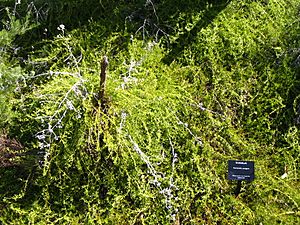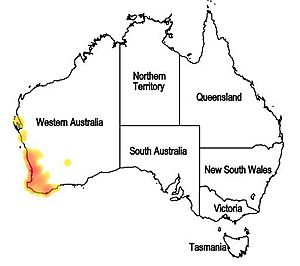Snakebush facts for kids
Quick facts for kids Snakebush |
|
|---|---|
 |
|
 |
|
| Scientific classification | |
| Genus: |
Hemiandra
|
| Species: |
pungens
|
 |
|
| Synonyms | |
|
Hemiandra brevifolia Benth. |
|
Hemiandra pungens, also known as snakebush, is a cool plant that grows in southwestern Western Australia. It's a type of shrub or a plant that trails along the ground.
What Does it Look Like?
This plant can be quite small, about 5 centimeters tall, or grow up to 100 centimeters (about 3 feet) high. You can find it growing on rocky areas. The snakebush is a very changeable plant. It might grow as a low, trailing plant or as a small bush.
Its flowers are often spotted and can be white, pink, or even bluish-purple. You can see these pretty flowers throughout the year, but they are especially common in the spring.
How Was it Named?
The snakebush was officially described in 1810 by a Scottish botanist named Robert Brown. He was the first to give it its scientific name.
Sometimes, you might hear about a type of snakebush that doesn't have hairs on its stems or leaves. This version is sometimes called Hemiandra pungens var. glabra or even Hemiandra glabra. It's basically a slightly different looking version of the same plant.
How to Grow Snakebush
It's usually hard to find seeds for the snakebush. But don't worry, it's quite easy to grow new plants from cuttings! This means you can take a small piece from an existing plant and help it grow roots.
You can also graft it onto other related plants, like Westringia fruticosa. Grafting is when you join parts of two plants so they grow as one.
Snakebush grows best in dry places, especially where summers are not too humid. It loves sunny spots with soil that drains water well. You can even grow it in containers, like hanging baskets, to show off its trailing branches and colorful flowers.

